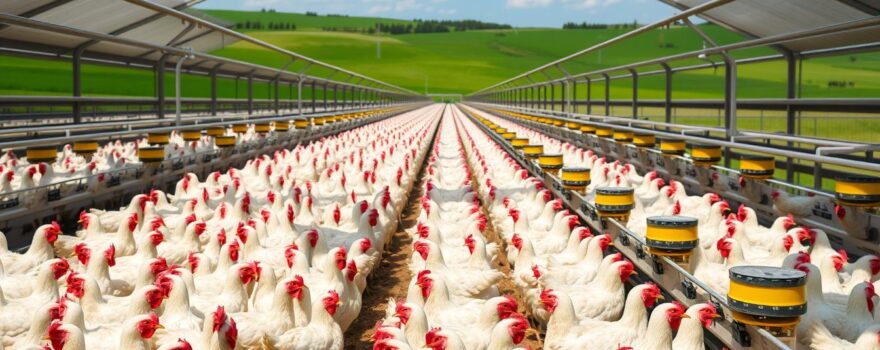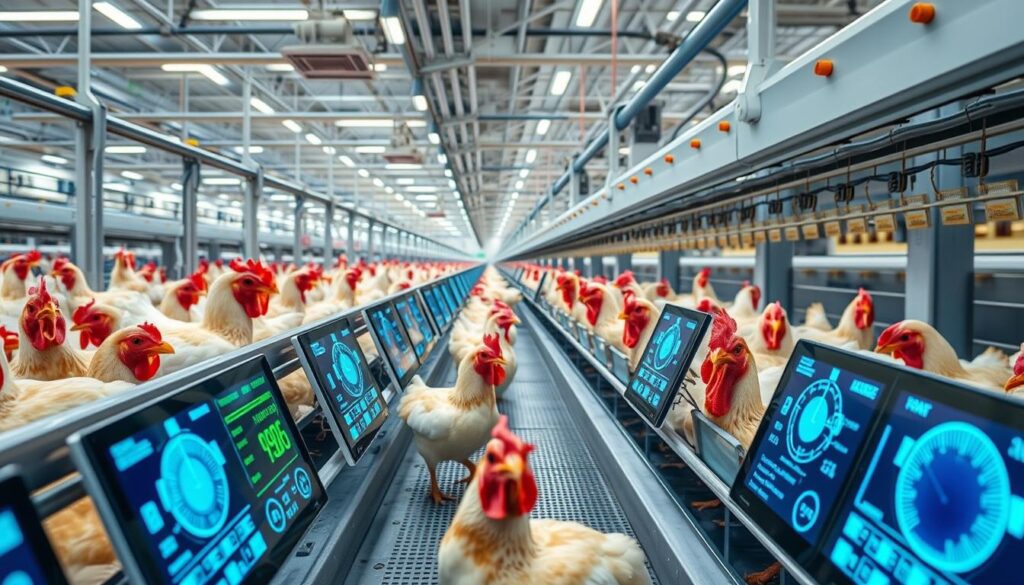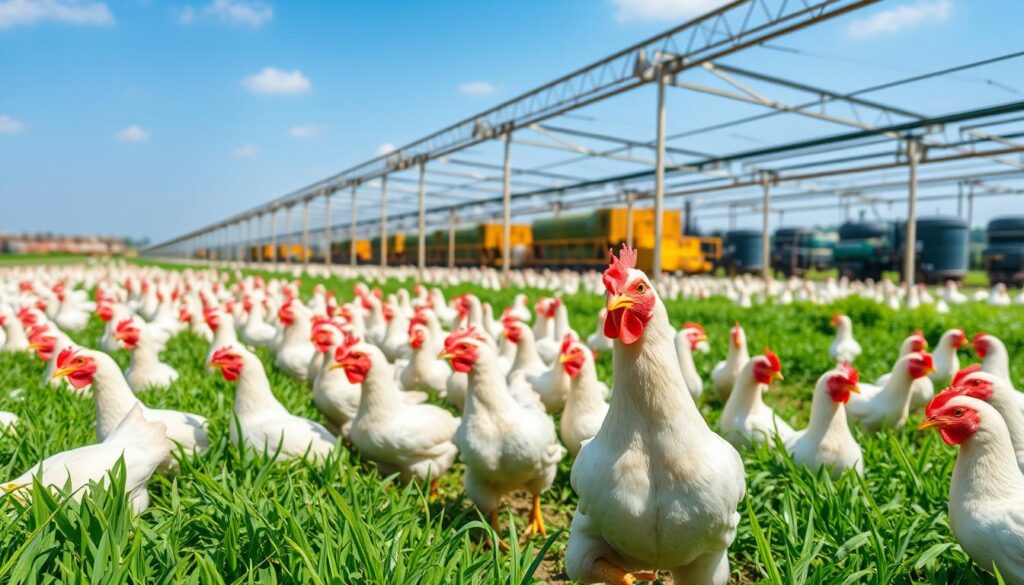
In today’s fast-changing world of agriculture, broiler chickens are leading the way. They are the most common type of chicken raised for meat. The demand for affordable, healthy protein is growing, and broiler chickens are at the heart of this change. They are driving progress with new technologies, breeding programs, and green farming methods.
This article looks at how broiler chickens are changing poultry farming. We’ll see how they help grow chickens efficiently and use new farming methods. We’ll also talk about their importance in the industry, the genetic improvements that boost their productivity, and the green farming practices they support.
We’ll also look at how vertical integration helps in the broiler chicken supply chain. This approach offers many benefits to farmers. Plus, we’ll highlight the work of top broiler chicken breeders like Aviagen, Cobb-Vantress, and Hubbard. They play a key role in shaping the industry’s future.
The story of broiler chickens shows the poultry industry’s ability to adapt and innovate. Join us as we explore how these birds are changing poultry farming for the better.
Key Takeaways
- Broiler chickens are driving the future of poultry farming through advancements in genetics, sustainability, and technology.
- The industry’s focus on efficient growth and the adoption of precision livestock farming techniques are transforming the way broiler chickens are produced.
- Sustainable production practices that address environmental impact and animal welfare concerns are becoming increasingly important in the broiler chicken industry.
- Vertical integration in the broiler chicken supply chain is bringing significant benefits to producers, enabling them to optimize their operations.
- Leading broiler chicken breeders are making significant contributions to the industry’s genetic advancements and efficiency improvements.
Introduction to Broiler Chickens
Broiler chickens, also known as meat chickens, are the most common type of chicken raised for commercial meat production. They are bred to grow fast and convert feed into muscle efficiently. This makes them key in the broiler chicken industry. They are vital in modern poultry farming for meeting the world’s demand for affordable, high-quality protein.
Understanding the Broiler Chicken Industry
The broiler chicken industry is complex and efficient. It involves many stakeholders, from breeders and hatcheries to farmers and processors. Together, they ensure a steady supply of broiler chickens. These chickens are raised in controlled environments, focusing on growth, feed efficiency, and animal welfare.
Significance of Broiler Chickens in Modern Poultry Farming
Broiler chickens are crucial in the modern poultry farming industry. They provide a reliable and affordable protein source worldwide. Their fast growth, large size, and docile nature make them perfect for large-scale production. Advances in genetics and nutrition have also improved their efficiency and sustainability.
| Breed | Growth Rate | Feed Conversion Ratio | Processing Age |
|---|---|---|---|
| Cornish Cross | 1.5-2.0 lbs/week | 1.6-1.8 | 6-8 weeks |
| Freedom Rangers | 1.0-1.5 lbs/week | 2.0-2.5 | 10-12 weeks |
| Dual-Purpose Breeds | 0.8-1.2 lbs/week | 2.5-3.0 | 12-16 weeks |
The table shows the differences in growth rate, feed conversion ratio, and processing age among broiler chicken breeds. It highlights the broiler chicken industry’s role in modern poultry farming.
“Broiler chickens are the most efficient and cost-effective way to produce high-quality protein for the growing global population.”
Efficient Broiler Chicken Growth
The poultry industry has seen big improvements in broiler chickens growth and feed use. Breeding programs have focused on traits that help chickens grow faster and healthier. This makes them ready for slaughter sooner and more efficiently.
Genetic Advancements in Broiler Breeds
Genetic progress is key to broiler chicken efficiency. Poultry scientists have found and enhanced genes for fast growth and better feed use. This has led to broiler breeds that grow quicker and eat less.
- Selective breeding for faster growth has made broilers reach slaughter weight up to 30% quicker.
- Broilers now convert feed into meat more efficiently, cutting costs and environmental impact.
- Genetic improvements have also boosted disease resistance, livability, and carcass quality.
These genetic advancements in broiler breeds help meet the world’s growing chicken meat demand. They also make farming more efficient and profitable for poultry farmers.
“The continuous improvement in broiler chicken genetics has been a key driver in the poultry industry’s ability to produce more meat with fewer resources.”
Precision Livestock Farming for Broilers
The broiler chicken industry is using new technologies to improve how it farms. It’s collecting data on things like how much feed birds eat and how fast they grow. This helps farmers make better choices to raise healthier birds and use resources better.
Advanced sensors and monitoring systems are key in this effort. They track the health and performance of birds. This information helps farmers adjust how they care for the birds, like what food to give them and how to keep them comfortable.
Data analysis and predictive models are also important. They help farmers understand big data to make better decisions. This way, farmers can work more efficiently, reduce waste, and raise more birds.
| Key Advantages of Precision Livestock Farming for Broilers |
|---|
|
The future of broiler chicken farming looks bright with precision livestock farming. By using data and analytics, farmers can make their operations more efficient and sustainable. This leads to better farming practices and more success for the industry.

“Precision livestock farming is not just about technology; it’s about transforming the way we approach poultry production, putting data and insights at the heart of our decision-making process.”
Sustainable Broiler Chicken Production Practices
The broiler chicken industry is moving towards more sustainable ways. It aims to lessen its environmental impact and improve animal care. Broiler producers are now focusing on efficient methods and responsible use of resources.
Environmental Impact Reduction Strategies
Broiler farms are taking steps to reduce their environmental impact. They are using new ways to manage waste, turning poultry litter into organic fertilizers. They are also adding renewable energy sources like solar panels and wind turbines to cut down on carbon emissions and energy use.
Water conservation is key in sustainable broiler production. Producers are using advanced water recycling systems and precision irrigation. These steps help save water and reduce waste, making the industry more sustainable.
Animal Welfare Considerations
Broiler chicken welfare is now a major focus. Producers are improving living conditions with better lighting, ventilation, and enriched environments. This makes life better for broiler chickens.
Feeding practices have also changed. Now, broiler chickens get balanced and nutritious diets. Health monitoring systems have been improved to catch diseases early. This reduces the need for antibiotics and keeps flocks healthy.
| Sustainable Broiler Production Strategies | Key Benefits |
|---|---|
| Waste Management | Conversion of poultry litter into organic fertilizers |
| Renewable Energy Integration | Reduced carbon emissions and energy consumption |
| Water Conservation | Efficient water usage and recycling |
| Improved Housing and Feeding | Enhanced broiler chicken welfare and health |
By adopting these sustainable practices, the industry is making big strides. It’s reducing environmental impact and focusing on animal welfare. These changes are leading to a more responsible and forward-thinking poultry sector.
How Broiler Chickens are Shaping the Future of Poultry Farming
Broiler chickens are leading the way in the poultry industry’s growth. They are driving innovation and setting the future’s tone. Advances in genetics, precision farming, and sustainable practices are making broiler chicken production more efficient. This meets the increasing global demand for chicken meat while also addressing environmental and animal welfare issues.
Genetic improvements have made broiler chickens grow faster and yield more. This makes them a more efficient and cost-effective choice for farmers. Precision livestock farming techniques, like sensors and data analytics, have also changed how broiler chickens are raised. These methods improve their health, welfare, and productivity.
Sustainability is a big focus in the broiler chicken industry. Farmers are using new strategies to lessen the environmental impact of broiler production. This includes waste management systems and renewable energy sources. There’s also a greater focus on animal welfare, with better housing and humane slaughter practices becoming standard.
“Broiler chickens are at the forefront of shaping the future of poultry farming, driving innovation and setting the tone for the industry’s direction.”
As the demand for chicken meat grows, broiler chickens will play a key role in poultry farming’s future. Their efficient growth and the industry’s focus on sustainability and animal welfare are shaping a future. This future prioritizes meeting the world’s protein needs while caring for the environment and animals.
Vertical Integration in the Broiler Chicken Supply Chain
The broiler chicken industry has adopted vertical integration. This means companies manage different parts of the supply chain. It has brought many benefits, like better efficiency, quality control, and meeting market needs.
Benefits of Vertical Integration for Broiler Producers
Vertical integration in the broiler chicken supply chain has many advantages for producers:
- It improves coordination and control over production, ensuring quality and following industry standards.
- It makes operations more efficient and reduces costs, leading to higher profits.
- It helps producers quickly respond to market changes and consumer preferences.
- It reduces the risk of supply chain problems since companies control their materials and distribution.
- It opens up chances for producers to diversify their products and reach new markets.
| Benefit | Description |
|---|---|
| Coordination and Quality Control | Vertically integrated companies can closely monitor and manage the entire production process, from breeding to processing, ensuring consistent quality and efficiency. |
| Cost Optimization | By eliminating intermediaries and streamlining operations, vertically integrated broiler producers can reduce costs and improve profit margins. |
| Adaptability to Market Changes | Vertical integration enables broiler producers to quickly respond to evolving consumer preferences and market conditions, maintaining a competitive edge. |
| Supply Chain Resilience | Vertically integrated companies have greater control over their supply chain, reducing the risk of disruptions and ensuring a reliable source of raw materials. |
| Product Diversification | Vertical integration allows broiler producers to expand their product offerings, catering to a wider range of customer segments and market opportunities. |
Overall, vertical integration in the broiler chicken supply chain has helped producers succeed in the long run. It drives innovation and makes them more responsive in the poultry industry.
Poultry Farming Innovations Driven by Broiler Chickens
The poultry industry has seen big changes, thanks to broiler chickens. These birds are key to new ideas in farming. They help make farming better and more efficient.
Broiler chickens have led to new ways of breeding and farming. Scientists have created breeds that grow fast and do well in many places. This has changed how farmers manage their farms and use resources.
Broiler chickens also help with farming in a way that’s good for the planet. Farmers use new tech, like precision livestock farming, to care for animals better and use less resources. This is because people want chicken that’s raised right.
Broiler chickens are also key in making farming more connected. From hatching to processing, everything works together better. This means less waste and better food for everyone.
| Innovation | Impact on Poultry Farming |
|---|---|
| Genetic Advancements in Broiler Breeds | Improved growth rates, feed efficiency, and disease resistance |
| Precision Livestock Farming Technologies | Enhanced animal welfare, reduced environmental footprint, and optimized resource utilization |
| Vertical Integration in the Supply Chain | Streamlined operations, reduced waste, and improved traceability |
Broiler chickens keep changing poultry farming for the better. They help make farming more efficient and green. This is good for the planet and for people who eat chicken.
“Broiler chickens have been the cornerstone of poultry farming innovation, pushing the industry forward with their remarkable productivity and adaptability.”
The future of poultry farming depends on broiler chickens. They help meet the needs of people and the planet.
Leading Broiler Chicken Breeders: Aviagen, Cobb-Vantress, Hubbard
The broiler chicken industry is led by a few key players. Aviagen, Cobb-Vantress, and Hubbard are at the forefront. They are known for their work in genetics and improving production efficiency.
Contributions to Broiler Chicken Genetics and Efficiency
These companies have invested heavily in research. They focus on breeding chickens that grow fast, eat less, and have better meat quality. Their work has changed the industry, making chickens more productive and adaptable.
| Breeder | Key Contributions | Impact on Broiler Chickens |
|---|---|---|
| Aviagen |
|
Improved growth rates, feed efficiency, and meat quality |
| Cobb-Vantress |
|
Increased production efficiency and disease resistance |
| Hubbard |
|
Improved animal welfare and diversified broiler production options |
The work of Aviagen, Cobb-Vantress, and Hubbard has been crucial. They have helped the industry grow. Now, broiler chickens are a reliable and efficient source of protein worldwide.
Broiler Chicken Production: Meeting Global Protein Demand
The world’s population is growing fast, leading to a huge need for protein-rich foods. The broiler chicken industry is key in meeting this demand. It produces a lot of high-quality, affordable protein. This is thanks to broiler chickens’ quick growth and efficient use of feed.
In places where protein is hard to get, broiler chicken is a top choice. It’s a cost-effective way to get protein, making it popular in many areas.
Broiler chicken production is essential for providing sustainable and affordable protein globally. Thanks to new breeding and farming methods, broiler chickens grow faster and use less feed. This makes their meat a great, affordable choice for people everywhere.
| Region | Broiler Chicken Production (million metric tons) | Percentage of Global Broiler Chicken Production |
|---|---|---|
| Asia-Pacific | 55.6 | 43% |
| Americas | 48.3 | 37% |
| Europe | 21.4 | 16% |
| Africa | 4.7 | 4% |
The table shows how important broiler chicken production is worldwide. The Asia-Pacific and Americas lead in producing broiler chicken.
The broiler chicken industry must keep innovating to meet the world’s food needs. Its efficiency and innovation will be key in the future of poultry farming.

Challenges and Opportunities in Broiler Chicken Farming
The broiler chicken industry has made big strides, but it faces many challenges. It needs to tackle antibiotic resistance and improve disease management. This is crucial for the long-term health and safety of broiler chicken farming.
Addressing Antibiotic Resistance and Disease Management
The use of antibiotics in broiler chicken farming has led to antibiotic-resistant bacteria. This is a big threat to both animal and human health. To solve this, we need to use new feed, better biosecurity, and strict vet rules.
Disease management is also a big worry. Diseases like avian influenza and Marek’s disease can hurt producers a lot. We need to watch for diseases closely, use vaccines, and have the latest diagnostic tools.
But, the broiler chicken industry also has big chances for growth. New genetics, precision farming, and green practices can make farming better. They can make it more efficient, better for animals, and kinder to the environment.
| Challenge | Opportunity |
|---|---|
| Antibiotic Resistance | Alternative feed formulations, improved biosecurity, and veterinary oversight |
| Disease Management | Proactive disease surveillance, vaccination programs, and advanced diagnostics |
| Environmental Impact | Sustainable production practices and precision livestock farming |
By facing these challenges and taking the opportunities, the broiler chicken industry can keep growing. It can meet the world’s need for good, affordable protein. And it can do it while caring for animals and the environment.
The Future of Broiler Chickens: Emerging Trends and Innovations
The broiler chicken industry is changing fast. New trends and tech are coming in. These changes will make the industry better for the environment and animals.
One big change is precision farming. This uses advanced tech to care for chickens better. It makes sure they get the right food and water. This way, chickens grow healthier and happier.
Another big change is using clean energy. Farms are starting to use solar panels and biogas digesters. This helps reduce harm to the environment. As people want more eco-friendly choices, these changes are key for the industry’s future.